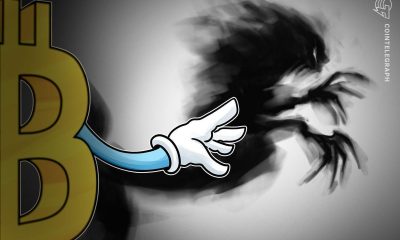

others
Japanese Yen remains on the front foot against USD, dovish BoJ expectations cap gains – Crypto News
- The Japanese Yen is seen extending the overnight recovery against the USD from a one-month low.
- Expectations that the BoJ will stick to its ultra-dovish policy stance should cap the upside for the JPY.
- Reduced bets for a more aggressive Fed easing could lend support to the buck and the USD/JPY pair.
The Japanese Yen (JPY) scales higher for the second consecutive day against its American counterpart on Friday and recovers further from a one-month low touched in the aftermath of the US consumer inflation figures. Against the backdrop of China’s economic woes, the risk of a further escalation of geopolitical tensions in the Middle East is seen as a key factor benefitting the JPY’s relative safe-haven status. Apart from this, subdued US Dollar (USD) price action exerts some downward pressure on the USD/JPY pair.
A slightly hot headline US Consumer Price Index (CPI), along with comments by Fed officials, fueled speculations that interest rates in the US could stay higher for longer. That said, the markets are still pricing in a greater chance of an imminent shift in the Fed’s policy stance in March. This acts as a headwind for US Treasury bond yields and weighs on the USD. The downside for the USD/JPY pair, however, remains cushioned amid growing acceptance that the Bank of Japan (BoJ) will not pivot away from its ultra-dovish stance.
The aforementioned mixed fundamental backdrop makes it prudent to wait for strong follow-through selling before placing fresh bearish bets and confirming that the USD/JPY pair’s recent goodish recovery from a multi-month low has run its course. Traders now look to the US Producer Price Index (PPI), which along with Minneapolis Fed President Neel Kashkari’s speech, might influence the USD and provide some impetus. Nevertheless, the currency pair still seems poised to end in the green for the second consecutive week.
Daily Digest Market Movers: Japanese Yen is undermined by reviving safe-haven demand, lacks follow-through
- The Bank of Japan is expected to stick to the ultra-loose monetary policy setting at its meeting on January 22-23, which continues to undermine the Japanese Yen.
- The US consumer inflation figures released on Thursday raise doubts that the Federal Reserve will cut rates in March and lend some support to the USD/JPY pair.
- The Labor Department reported on Thursday that the headline US CPI climbed 0.3% and accelerated from 3.1% to 3.4% over the 12 months through December.
- Excluding the volatile food and energy prices, the core gauge rose by 0.3% last month and advanced 3.9% YoY in December, registering its smallest gain since May 2021.
- Cleveland Fed President Loretta Mester commented on the latest CPI figures and said that that it would likely be too soon for the US central bank to cut its interest rates at the March policy meeting.
- Adding to this, Richmond Fed chief Tom Barkin noted that the central bank needs to be convinced that inflation is headed to target and will be open to lowering rates once inflation is on track to 2%.
- Seperately, Chicago Fed Austan Goolsbee said that the central bank is still on a comfortable path forward on inflation and will have to evaluate policy restrictiveness as inflation continues to decline.
- Expectations for an imminent shift in the Fed’s policy stance drags the US Treasury bond yields lower and might hold back the USD bulls from placing aggressive bets.
- According to CNN, the US and UK forces carried out attacks against multiple Houthi targets in reaction to repeated drone and missile attacks on ships in the Red Sea.
- Traders now look to the US Producer Price Index (PPI), which, along with Minneapolis Fed President Neel Kashkari’s speech, should provide a fresh impetus.
- The headline PPI is anticipated to rise by 1.3% YoY in December from 0.9% previous, while the core PPI is seen ticking down to 1.9% from 2.0% in November.
Technical Analysis: USD/JPY shows some resilience below the 145.00 mark and the 50% Fibo. level
From a technical perspective, the USD/JPY pair is placed around the 145.00 psychological mark and flirting with the 50% Fibonacci retracement level of this week’s move-up. A sustained break and acceptance below the said handle will set the stage for an extension of the overnight corrective pullback from a one-month peak. Given that oscillators on the 1-hour chart are holding in the negative territory, some follow-through selling below the 100-hour Simple Moving Average (SMA), currently around the 144.80 region, will be seen as a fresh trigger for intraday bearish traders. Spot prices might then accelerate the downfall towards the 61.8% Fibo. level, around the 144.55 area, before dropping to the next relevant support near the 144.10-144.00 region.
On the flip side, the 145.55-145.60 horizontal zone might act as an immediate hurdle ahead of the 146.00 round figure. A sustained strength beyond the latter has the potential to lift the USD/JPY pair further towards the monthly peak, around the 146.40 area touched on Thursday. The momentum could extend further and allow bulls to aim to reclaim the 147.00 mark and then challenge the 100-day SMA, currently pegged near the 147.45 region.
Japanese Yen price today
The table below shows the percentage change of Japanese Yen (JPY) against listed major currencies today. Japanese Yen was the strongest against the Swiss Franc.
| USD | EUR | GBP | CAD | AUD | JPY | NZD | CHF | |
| USD | 0.00% | -0.01% | -0.05% | -0.15% | 0.02% | -0.11% | 0.06% | |
| EUR | 0.00% | -0.02% | -0.05% | -0.19% | 0.00% | -0.15% | 0.07% | |
| GBP | 0.03% | 0.03% | -0.03% | -0.14% | 0.02% | -0.10% | 0.10% | |
| CAD | 0.05% | 0.04% | 0.03% | -0.16% | 0.06% | -0.06% | 0.11% | |
| AUD | 0.19% | 0.18% | 0.17% | 0.14% | 0.19% | 0.05% | 0.26% | |
| JPY | -0.01% | 0.00% | -0.02% | -0.08% | -0.17% | -0.15% | 0.06% | |
| NZD | 0.13% | 0.15% | 0.14% | 0.09% | -0.01% | 0.17% | 0.22% | |
| CHF | -0.05% | -0.05% | -0.06% | -0.11% | -0.21% | -0.05% | -0.16% |
The heat map shows percentage changes of major currencies against each other. The base currency is picked from the left column, while the quote currency is picked from the top row. For example, if you pick the Euro from the left column and move along the horizontal line to the Japanese Yen, the percentage change displayed in the box will represent EUR (base)/JPY (quote).
Bank of Japan FAQs
The Bank of Japan (BoJ) is the Japanese central bank, which sets monetary policy in the country. Its mandate is to issue banknotes and carry out currency and monetary control to ensure price stability, which means an inflation target of around 2%.
The Bank of Japan has embarked in an ultra-loose monetary policy since 2013 in order to stimulate the economy and fuel inflation amid a low-inflationary environment. The bank’s policy is based on Quantitative and Qualitative Easing (QQE), or printing notes to buy assets such as government or corporate bonds to provide liquidity. In 2016, the bank doubled down on its strategy and further loosened policy by first introducing negative interest rates and then directly controlling the yield of its 10-year government bonds.
The Bank’s massive stimulus has caused the Yen to depreciate against its main currency peers. This process has exacerbated more recently due to an increasing policy divergence between the Bank of Japan and other main central banks, which have opted to increase interest rates sharply to fight decades-high levels of inflation. The BoJ’s policy of holding down rates has led to a widening differential with other currencies, dragging down the value of the Yen.
A weaker Yen and the spike in global energy prices have led to an increase in Japanese inflation, which has exceeded the BoJ’s 2% target. Still, the Bank judges that the sustainable and stable achievement of the 2% target has not yet come in sight, so any sudden change in the current policy looks unlikely.
-

 Technology1 week ago
Technology1 week agoGiving Nvidias Blackwell chip to China would slash USs AI advantage, experts say – Crypto News
-

 De-fi1 week ago
De-fi1 week agoBittensor Rallies Ahead of First TAO Halving – Crypto News
-

 Business1 week ago
Business1 week agoStarbucks Says Turnaround Strategy Drives Growth in Global Sales – Crypto News
-

 others1 week ago
others1 week agoMETA stock has lower gaps to fill – Crypto News
-

 De-fi1 week ago
De-fi1 week agoBitcoin Dips Under $110,000 After Fed Cuts Rates – Crypto News
-

 Cryptocurrency4 days ago
Cryptocurrency4 days agoAndrew Tate Buys $5 Million Worth of Bitcoin Hours Before Crash – Crypto News
-
Cryptocurrency1 week ago
After 1,993% Burn Spike, Is Shiba Inu Price Set for a Major Trend Reversal? – Crypto News
-
others1 week ago
Crypto Market Tumbles as Jerome Powell Says December Rate Cut ‘Far From Certain’ – Crypto News
-

 Blockchain1 week ago
Blockchain1 week agoSmart Money Buys the Dip – Crypto News
-

 Cryptocurrency3 days ago
Cryptocurrency3 days agoMany Crypto Treasury Companies Were a Get-Rich-Quick Trap, Warns Columbia Professor – Crypto News
-

 Metaverse1 week ago
Metaverse1 week agoAI boom is just beginning – Nvidia CEO Jensen Huang explains what’s driving the virtuous cycle – Crypto News
-

 Cryptocurrency4 days ago
Cryptocurrency4 days agoAndrew Tate Buys $5 Million Worth of Bitcoin Hours Before Crash – Crypto News
-

 Cryptocurrency3 days ago
Cryptocurrency3 days agoBitcoin tests $100K support after massive liquidation event rocks market – Crypto News
-

 Cryptocurrency1 week ago
Cryptocurrency1 week agoArbitrum beats Ethereum in inflows: Yet ARB price lags – Here’s why – Crypto News
-

 Blockchain1 week ago
Blockchain1 week agoBasel Reportedly Aims for Friendlier Crypto Bank Guidelines – Crypto News
-

 Cryptocurrency7 days ago
Cryptocurrency7 days agoZIGChain eyes gains as Nasdaq-Listed SEGG Media backs ZIG – Crypto News
-

 Cryptocurrency4 days ago
Cryptocurrency4 days agoLitecoin: $855K ETF inflow sparks new life – Next target is $105 IF… – Crypto News
-

 Cryptocurrency3 days ago
Cryptocurrency3 days agoStrategy IPO redefines corporate Bitcoin strategy with euro-denominated offering – Crypto News
-

 Blockchain1 week ago
Blockchain1 week agoCZ Weighing Lawsuit Against US Senator over Money Laundering Claim: Report – Crypto News
-

 others1 week ago
others1 week agoGBP/USD tests six months lows as Pound Sterling continues to sink – Crypto News
-
Business1 week ago
Not L1s or Wallets – Who Generates the Bulk of Crypto’s $20B in Revenue? – Crypto News
-

 Cryptocurrency1 week ago
Cryptocurrency1 week agoIs the Market Finally Learning to Handle Volatility? – Crypto News
-

 Cryptocurrency5 days ago
Cryptocurrency5 days agoRipple Just Made XRP and RLUSD Tradeable Like Stocks: Here’s How – Crypto News
-

 Blockchain5 days ago
Blockchain5 days agoStablecoin Orchestration Becomes FinTech Battleground – Crypto News
-
others4 days ago
“Never Had Plans to Sue Binance,” Wintermute CEO Evgeny Gaevoy Confirms – Crypto News
-

 Cryptocurrency3 days ago
Cryptocurrency3 days agoBittensor (TAO) plunges 16% amid broader crypto sell-off – Crypto News
-
Business1 week ago
WLF Token Jumps 7% as Former Robinhood Counsel Joins Trump-Backed World Liberty Financial – Crypto News
-

 Technology1 week ago
Technology1 week agoInjective (INJ) completes its first community buyback worth $32 million – Crypto News
-

 Technology1 week ago
Technology1 week agoEthereum Foundation launches institutional portal to boost enterprise adoption – Crypto News
-
Business1 week ago
Bitcoin Price Forecast as Trump Cuts Tariffs After US-China Trade Deal – Crypto News
-
others1 week ago
Cardano Price Risks 20% Crash Amid Death Cross and Falling ADA ETF Odds – Crypto News
-
Technology1 week ago
Canary XRP ETF Filing Removes SEC Delay Clause, Targets November Launch – Crypto News
-

 Blockchain1 week ago
Blockchain1 week agoXRP Chart Mirrors Gold Right Before Its Parabolic Run – Crypto News
-

 De-fi1 week ago
De-fi1 week agoFourMeme Surpasses Pumpfun With $43 Million in Monthly Revenue – Crypto News
-
Technology1 week ago
XRP Price Outlook as ETF Nears Possible November 13 Launch – Crypto News
-

 Technology1 week ago
Technology1 week agoCities Deploy Robots as Firefighters, Tour Guides and Lawnmowers – Crypto News
-
others1 week ago
Russia S&P Global Manufacturing PMI dipped from previous 48.2 to 48 in October – Crypto News
-

 Cryptocurrency1 week ago
Cryptocurrency1 week agoHBAR under pressure, Descending channel hints at 24% downside move – Crypto News
-

 Metaverse1 week ago
Metaverse1 week agoPerplexity AI CEO Aravind Srinivas touts new feature revealing Indian politicians’ stock holdings—How will it work? – Crypto News
-
others7 days ago
Pi Coin Price Prediction After AI Investment Announcement – Is a Bull Run Ahead? – Crypto News
-

 Blockchain5 days ago
Blockchain5 days agoTokenized Treasuries cross $8.6B as banks and exchanges push collateral use – Crypto News
-

 Blockchain1 week ago
Blockchain1 week agoEvernorth Has Reached 95% Of Its XRP Treasury Target – Crypto News
-

 De-fi1 week ago
De-fi1 week agoNEAR Cuts Inflation Rate by Half Despite Failed Community Vote – Crypto News
-

 Technology1 week ago
Technology1 week agoGHOST extends rally as whale scoops 4.8 million tokens – Crypto News
-

 Blockchain1 week ago
Blockchain1 week agoQuantum Computing Still Years from Threatening Bitcoin, Says VC Amit Mehra – Crypto News
-

 others7 days ago
others7 days agoGBP/USD hits seven-month low as UK fiscal woes, Fed hawkishness weigh – Crypto News
-

 Blockchain6 days ago
Blockchain6 days agoBitcoin In IPO Phase As Early Holders Give Way to New Investors – Crypto News
-

 Blockchain6 days ago
Blockchain6 days agoChainlink Maintains Its Base, But One Push Could Flip Sentiment Fast – Crypto News
-

 Metaverse6 days ago
Metaverse6 days agoDoes Nvidia’s $5-trillion feat raise the spectre of an AI winter? – Crypto News
-

 Blockchain6 days ago
Blockchain6 days agoWill Bitcoin’s Latest Sunday Pump be Different This Time? – Crypto News








